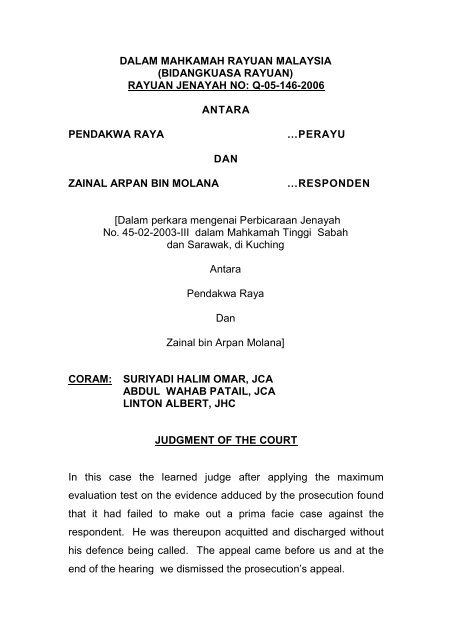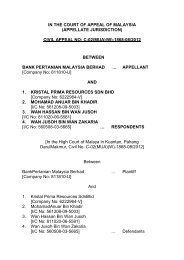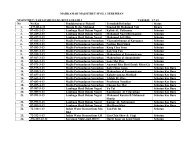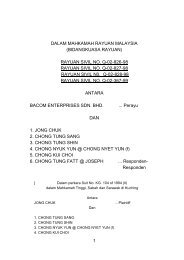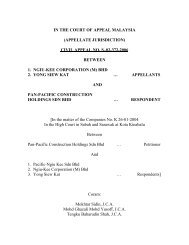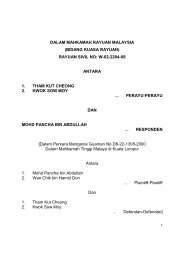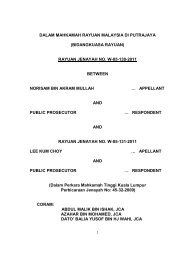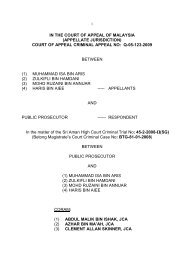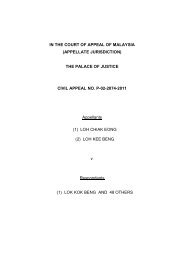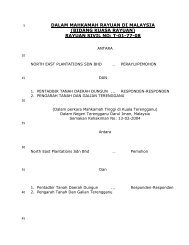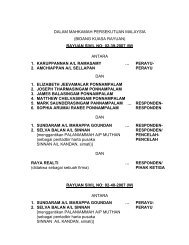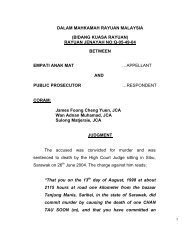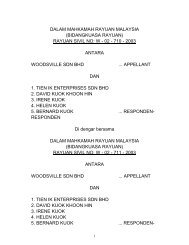rayuan jenayah no: q-05-146-2006 antara pendakwa raya
rayuan jenayah no: q-05-146-2006 antara pendakwa raya
rayuan jenayah no: q-05-146-2006 antara pendakwa raya
Create successful ePaper yourself
Turn your PDF publications into a flip-book with our unique Google optimized e-Paper software.
DALAM MAHKAMAH RAYUAN MALAYSIA<br />
(BIDANGKUASA RAYUAN)<br />
RAYUAN JENAYAH NO: Q-<strong>05</strong>-<strong>146</strong>-<strong>2006</strong><br />
ANTARA<br />
PENDAKWA RAYA …PERAYU<br />
DAN<br />
ZAINAL ARPAN BIN MOLANA …RESPONDEN<br />
[Dalam perkara mengenai Perbicaraan Jenayah<br />
No. 45-02-2003-III dalam Mahkamah Tinggi Sabah<br />
dan Sarawak, di Kuching<br />
Antara<br />
Pendakwa Raya<br />
Dan<br />
Zainal bin Arpan Molana]<br />
CORAM: SURIYADI HALIM OMAR, JCA<br />
ABDUL WAHAB PATAIL, JCA<br />
LINTON ALBERT, JHC<br />
JUDGMENT OF THE COURT<br />
In this case the learned judge after applying the maximum<br />
evaluation test on the evidence adduced by the prosecution found<br />
that it had failed to make out a prima facie case against the<br />
respondent. He was thereupon acquitted and discharged without<br />
his defence being called. The appeal came before us and at the<br />
end of the hearing we dismissed the prosecution’s appeal.
The charge against the respondent reads as follows:<br />
2<br />
“That you, on 17.10.2002, at about 10.45 pm at Lot 3640, Taman<br />
Rasa Makmur, Petra Jaya, in the State of Sarawak, on your own<br />
behalf did traffic in a dangerous drug, to wit, 197.99 grammes of<br />
methamphetamine, and you thereby committed an offence under<br />
s. 39(B)(1)(a) Dangerous Drug Act 1952 and punishable under s.<br />
39B(2) of the same Act.”<br />
At the opening stage of her submission before us the learned DPP<br />
indicated that she was using a dual prong approach to establish<br />
the prosecution’s case. For the first approach, she would apply<br />
the presumptive provision to establish mens rea for the ingredient<br />
of possession, and thereafter alluding to s. 2 of the Dangerous<br />
Drugs Act 1952 (the Act) to establish the ingredient of trafficking<br />
i.e. by direct evidence. The alternative was that the respondent by<br />
direct evidence had physical possession of the drugs, and to<br />
establish the ingredient of trafficking, she would allude to s. 2 of<br />
the Act. On the latter ingredient of trafficking, this approach<br />
differed with the one at the High Court, where the DPP there had<br />
stated that reliance would be on direct evidence and “on<br />
presumption under the Dangerous Drugs” to establish the<br />
ingredient of trafficking (see F of the Appeal Record Vol.2).<br />
Scrutinising the opening address at the High Court, it was obvious<br />
that the learned DPP never mentioned that she would lead<br />
evidence to establish possession of the drugs by the respondent.<br />
The emphasis was more on information supplied by him leading to<br />
discovery of the impugned drugs in his house. The brief facts are<br />
as follows. On 17/10/2002 at about 10.30 p.m. the respondent
3<br />
together with his wife and mother-in-law were in front of the Hilton<br />
Hotel, Kuching, when they were stopped by the police. He was<br />
arrested as he was alleged to have acted in a suspicious manner<br />
when walking towards a car bearing registration number QSF 57.<br />
The police then instructed him to drive the car to the Sarawak<br />
Contingent Police Headquarters and upon arrival searched the car.<br />
The police found <strong>no</strong> drugs in it. Whether this was a mere flaw in<br />
the interpretation of human psychology by the police, when it<br />
mistook the “walking towards the car” as suspicious, exacerbated<br />
by the eventual embarrassment of <strong>no</strong> drugs being found in the car,<br />
or linked to some other mischievous reason, we have <strong>no</strong> idea.<br />
The respondent’s day got worse when the police then informed<br />
him that he would be detained under s. 3(1) of the Drug<br />
Dependants (Treatment and Rehabilitation) Act 1983 for a urine<br />
test. We felt some intimidation had come into play here as at that<br />
stage there was <strong>no</strong> legitimate reason for him to undergo this test.<br />
What started as a suspicious walk had culminated in a journey to<br />
the remand centre to await a urine test. The prosecution, through<br />
SP6, revealed that as the respondent did <strong>no</strong>t want to go for that<br />
urine test he thereupon told the police that he had drugs. His<br />
words were as follows: “saya ada menyimpan dadah di rumah<br />
(hereinafter to be referred as the Hilton statements).” After those<br />
words were uttered he was cautioned in accordance with s. 37A(1)<br />
of the Act.<br />
Following this lead, the respondent was alleged to have brought<br />
the police team to a house at Lot 3640, Taman Rasa Makmur,<br />
Petra Jaya. The respondent said he lived in that house. The<br />
police was led to his bedroom on the 3 rd floor, and inside the room
4<br />
the police recovered two syringes from the connected bathroom,<br />
and 4 plastic packets containing substance suspected to be<br />
dangerous drugs (hereinafter this location will be referred as the<br />
bedroom area). Drugs were retrieved from the right side pocket of<br />
a shirt which was in the cupboard inside the bedroom. The<br />
respondent was supposed to have handed over the drugs and the<br />
2 syringes to the police.<br />
Thereafter the respondent led the police to a store room located on<br />
the ground floor of the house and took out a black bag printed with<br />
the words “Felda Security” (P14). He opened the bag and handed<br />
to the police a blue cloth bag containing 2 plastic packets each<br />
containing crystalline substance suspected to be drugs, a weighing<br />
scale carrying the brand “Thinner”, a yellow cloth bag printed<br />
“Bally” containing one impulse sealer, a travel charger box<br />
containing a roll of plastic packets and two keys to apartment<br />
No.1108, Somerset Gateway, Kuching (this location will hereinafter<br />
referred to as the store room drugs).<br />
Upon analysis by the chemist (PW5), all the drugs seized were<br />
analysed as methamphetamine weighing 197.99 grams. Founded<br />
on this set of evidence the respondent was charged with the<br />
offence of drug trafficking. The prosecution called eight witnesses,<br />
including the arresting officer, the chemist, the investigating officer<br />
(PW6), and offered witnesses to the respondent. In the course of<br />
the hearing the prosecution, after a trial with a trial, failed to have<br />
certain remarks made by the respondent admissible e.g. the oral<br />
statements “Itulah bilik tidur saya”. The rejection of this statement<br />
as we saw it, did <strong>no</strong>t destabilise the prosecution’s case as there
5<br />
was some evidence to prove that the bedroom was indeed used by<br />
the respondent, his wife and children. PW7 i.e. the father-in-law<br />
was the supplier of that piece of evidence.<br />
In its submission, the prosecution at the High Court ventilated that<br />
the respondent had clear possession of the drugs, and had the<br />
requisite k<strong>no</strong>wledge of the nature of the drugs possessed.<br />
Further, the respondent did traffic the drugs. The combined<br />
quantity of the drug far exceeded the “trigger” weight under s.<br />
37(da) (xvi) of the Act and thus was presumed to be trafficking in<br />
the drug. This course of action and approach was in consonant<br />
with the approach to be undertaken supplied in the opening<br />
speech.<br />
The respondent on the other hand submitted that the prosecution<br />
had failed to prove a prima facie case based on the following<br />
factors:<br />
1. by perusing the opening statement, much rested on the<br />
admissibility and credibility of the alleged statement made by<br />
him, which fell under s. 27 of the Evidence Act 1950. That<br />
being so the Court should <strong>no</strong>t consider the evidence of what<br />
happened at the house if the Court was <strong>no</strong>t satisfied that the<br />
alleged information elicited in front of the Hilton Hotel was<br />
credible or reliable;<br />
2. the prosecution had suggested that if drugs were found in<br />
the bedroom, then the respondent must be guilty. According<br />
to the respondent this surely was <strong>no</strong>t the correct proposition<br />
of law as looking at the facts of this case, drugs found in the
6<br />
bedroom was an insignificant 2.23 grams. There were many<br />
possible inferences that went with it be it in relation to<br />
possession or purpose;<br />
3. the uncontroverted evidence in so far as the bedroom was<br />
concerned was that the respondent’s wife and children lived<br />
with him. The facts here could <strong>no</strong>t be taken in isolation, and<br />
taken cumulatively a reasonable doubt had been created at<br />
the prosecution’s stage as regards possession;<br />
4. there were <strong>no</strong> finger prints evidence on the plastic packets,<br />
which contained the substances, and there was <strong>no</strong> nexus<br />
between the drugs and the weighing machine, sealing<br />
machine or the travel charger box. There was <strong>no</strong> evidence<br />
of drugs sticking on the items either; and<br />
5. under s. 37(d), the prosecution still have to prove that the<br />
respondent was in actual custody or in control of dangerous<br />
drugs. The prosecution failed to prove that the respondent<br />
had exclusive use of the bedroom and store room. Without<br />
this legal prerequisite established the court could <strong>no</strong>t invoke<br />
s. 37(da) (xvi) of the Act. For the latter provision, in a<br />
nutshell, any person who is found in possession of 50 grams<br />
or more in weight of methamphetamine shall be presumed,<br />
until the contrary is proved, to be trafficking in the said drug.<br />
It was obvious from the <strong>no</strong>tes of proceedings that the learned<br />
judge had some trying moments with both the prosecution and the<br />
defence and had even conducted an unnecessary trial within a<br />
trial. She also had the occasion to hold that an alleged s.27<br />
statement made in the house was inadmissible. Regretfully for the<br />
prosecution, the Hilton statements which were alleged to have led
7<br />
to the discovery of the drugs were also held inadmissible on the<br />
grounds that the entries in the pocket diary were <strong>no</strong>t made<br />
contemporaneously and that the police team acted on prior<br />
information. It was our finding after thoroughly sifting the <strong>no</strong>tes of<br />
proceedings that the learned judge had applied the right legal<br />
principles when arriving at that conclusion. The reasons had<br />
<strong>no</strong>thing to do with the voluntariness of the statements as s. 27 is<br />
silent on this requirement unlike a confession or a cautioned<br />
statement (Francis Anthonysamy v Public Prosecutor [20<strong>05</strong>] 3 MLJ<br />
389; Chandrasekaran & Ors v Public Prosecutor [1971] 1 MLJ<br />
152).<br />
Perusing the grounds of judgment the learned judge had<br />
meticulously considered the opening address and their legal<br />
intricacies. She took great pains to state that it was mandatory<br />
and incumbent upon the prosecution before opening its case to<br />
state, inter alia, the proposed evidence to prove the guilt of the<br />
respondent and if the prosecution failed to mention an alleged<br />
admission, but only introduced it at the trial proper, then the<br />
evidence was an afterthought. We have <strong>no</strong> disagreement with this<br />
view either.<br />
Despite the want of mention of the ingredient of possession in the<br />
opening speech, the learned judge nevertheless proceeded to<br />
consider the strength and weakness of the respondent’s<br />
possession of the drugs. She eventually held that the prosecution<br />
failed to establish the ingredient of possession let alone the<br />
trafficking ingredient. Upon reading the grounds of judgment, it<br />
was obvious that the learned judged had applied the maximum
8<br />
evaluation test and thereupon concluded that the prosecution had<br />
failed to make out a prima facie case. There was <strong>no</strong>thing wrong in<br />
this test or eventual decision (Looi Kow Chai & A<strong>no</strong>r v Public<br />
Prosecutor [2003] 2 MLJ 65; PP v Mohd Radzi bin Abu Bakar<br />
[20<strong>05</strong>] 6 MLJ 393; Balachandran v PP [20<strong>05</strong>] 1 CLJ 85).<br />
The Court of Appeal’s additional factual finding<br />
Having perused the opening speech of the prosecution, it was<br />
obvious that the prosecution would rely heavily on the Hilton<br />
statements. Section 27 of the Evidence Act 1950 therefore would<br />
take the front seat for the prosecution. As it were the prosecution’s<br />
case was derailed when, proceeding on a finding of fact, the<br />
learned judge held those statements as being inadmissible.<br />
It must be understood that the format of her grounds of judgment<br />
were “broad grounds” hence the want of a detailed discussion of<br />
the s.27 statements in it but they sufficed. Her reasons were<br />
similar to “the grounds as summarised by the learned defence<br />
counsel...” Having read the defence written submissions and the<br />
connected evidence found in the <strong>no</strong>tes of proceedings, and<br />
simultaneously gauging the approach of the learned judge when<br />
arriving at that finding of fact, we failed to disagree with her.<br />
Moving on from there we realised that the decision of the learned<br />
judge to hold the statements made in front of the Hilton Hotel as<br />
inadmissible would have a profound overall effect on the case of<br />
the prosecution. Without that information, the case of the<br />
prosecution would take a serious twist, in that instead of the
9<br />
respondent leading the police to the discovery of the drugs the<br />
reverse holds true. The overall effect was that the recovery of the<br />
drugs even though successful, was instead carried out by the<br />
police in their <strong>no</strong>rmal course of investigation rather than discovered<br />
as a result of the respondent’s information.<br />
It was undeniable that the drugs founds came from two locations,<br />
namely the respondent’s bedroom, which had an attached<br />
bathroom, and the store room located on the ground floor of the<br />
house. The 2 sets of drugs were lumped together by the<br />
prosecution and the gross weight arrived at by the chemist was<br />
197.99 grams of methamphetamine. Needless to say the drugs<br />
retrieved from a shirt pocket in the bedroom, which weighed only<br />
2.23 grams, would <strong>no</strong>t have been sufficient to attract the<br />
presumptive provision of s. 37(da)(xvi) of the Act.<br />
Regardless of the finding of the learned judge regarding the issue<br />
of possession at page 861, we also undertook our own exercise<br />
pertaining to this ingredient. With there being a<strong>no</strong>ther person living<br />
in that bedroom i.e. the wife, could we safely say that the drugs<br />
were <strong>no</strong>t hers i.e. discounting any possession by the respondent?<br />
In Gooi Loo Seng v PP [1993] 2 MLJ 137 Edgar Joseph Jr. SCJ<br />
quashed the conviction on the grounds inter alia that the drugs<br />
could have been hidden by others, especially the girlfriend, who<br />
had access to the room and hidden the drugs there when the<br />
accused person was absent. We also had to bear in mind that 11<br />
people lived in that house, inclusive of his father-in-law, mother-in-<br />
law and the maid. When probed by us whether that shirt was<br />
owned by the father-in-law the learned DPP conceded that such a
10<br />
possibility was never eliminated at the High Court. When we<br />
pursued the matter and posed the follow up question of whether<br />
the shirt (P29) was actually a lady’s blouse, after having sight of<br />
the pictures, as it “looks like a female shirt”, again the learned DPP<br />
could <strong>no</strong>t confirm it either way. In a word that shirt could have<br />
been anybody’s. If it was the respondent’s drugs there was <strong>no</strong><br />
reason for him to hide them in a shirt possibly owned by some<br />
else, regardless of the sex, and thus risk the drugs being<br />
discovered. Putting it a<strong>no</strong>ther way, if the drugs were in someone<br />
else’s shirt then it was more likely that it was the owner of the shirt<br />
who hid the drugs in it, thus exonerating the respondent of having<br />
custody and control of them. Without these two ingredients being<br />
successfully established the issue of mens rea related to<br />
possession will <strong>no</strong>t be triggered: the stage of possession can only<br />
be considered after the custody and control hurdle have been<br />
cleared.<br />
Even if the learned judge had decided in favour of the prosecution<br />
regarding the Hilton statements, and even if the respondent had<br />
custody and control of the drugs found in the bedroom, we were<br />
<strong>no</strong>t convinced that the 2.23 grams of methamphetamine were for<br />
trafficking. There was every indication that the latter drugs were<br />
meant for self-consumption. The first indication was, if the 2.23<br />
grams drugs were meant for trafficking, why were they found at<br />
quite a distance from the larger amount found at the store room?<br />
Is insignificant size would clearly put it outside the reach of the<br />
presumption provision of trafficking.
11<br />
And then there were the syringes which were found in the<br />
bathroom. These 2 syringes were <strong>no</strong>t new and had been used at<br />
some point of time as the chemist found traces of ephedrine in<br />
them. In the course of the cross-examination SP6 admitted that<br />
those syringes were for drug taking (Q: Mengikut pengalaman<br />
kamu syringe itu untuk apa? J: Untuk mengambil dadah). It is<br />
undeniable that that there was some evidence supplied by the<br />
prosecution through SP6 (page 680 of the Appeal Record) to<br />
establish the respondent as a drug taker. On the above reasoning<br />
there was a high degree of probability that those syringes were<br />
part of his paraphernalia, and the 2.23 grams of methamphetamine<br />
were set aside to satisfy his drug cravings. To wind it up, if those<br />
drugs found in the bedroom were meant for possible self-<br />
consumption, to deliberately or even erroneously lump them with<br />
those found at the store room would seriously taint the trafficking<br />
charge. No amount of explanation by the prosecution could save<br />
the tainted charge.<br />
We <strong>no</strong>w discuss the drugs found at the store room. With the Hilton<br />
statements being held inadmissible, then the testimony adduced<br />
by the prosecution that the respondent led the police to the drugs<br />
at the store room on the ground floor of that 3 storey house, must<br />
be rejected. Nothing incriminating found there could be attributed<br />
to the respondent. It would be the police who led him to the store<br />
room and there recovered a black bag (P14) from a small<br />
compartment in which were retrieved drugs subsequently<br />
confirmed to be methamphetamine. There the police seized some<br />
other items too. Unless there was some evidence that could<br />
inculpate the respondent which led to the discovery of the drugs
12<br />
such discovery therefore could be premised on any reason<br />
imaginable. Without that incriminating evidence the drugs were<br />
merely recovered from the store room in a <strong>no</strong>rmal investigation<br />
rather than discovered pursuant to the respondent’s contribution.<br />
In order to establish the ingredient of possession of the drugs<br />
found at the store room (and the bedroom on the third floor), and<br />
hence having the requisite mens rea, be it by direct evidence or<br />
the invocation of the presumption provision, the prosecution must<br />
first of all cross the hurdle of having established custody and<br />
control of them. From the set of facts, <strong>no</strong>t only did the prosecution<br />
fail to establish that the respondent had custody and control of the<br />
drugs in his bedroom but also the drugs in the store room. For<br />
starters, the house was owned by his father-in-law and prima facie<br />
was the master of the house, together with its contents e.g. P14<br />
from which drugs were recovered. Evidentially P14, a bag that<br />
held the words “FELDA Security”, seized by the police in the store<br />
room and from which were retrieved the main bulk of the drugs and<br />
other items e.g. the “Thinner” weighing scale, a yellow cloth bag<br />
carrying the brand “Bally”, an impulse sealer and the like, was<br />
admitted by PW7 to be his (see Record of Appeal page 764). With<br />
P14 being his, why the latter was <strong>no</strong>t individually charged or jointly<br />
charged with the respondent was a mystery to us. He (PW7) also<br />
in clear terms testified that the house was occupied by <strong>no</strong> less than<br />
11 persons amongst them his maid, he and his wife, his daughter,<br />
the respondent and wife, and the respondent’s children. The<br />
spectre of all these people, especially the maid running loose in<br />
the house as she would have access to every part of the house,<br />
which would include the store room when doing her chores, would
13<br />
add to the whittling away of the respondent’s custody and control<br />
of the drugs. In Pang Chee Meng v Public Prosecutor [1992] 1<br />
MLJ 137 Abdul Hamid Omar LP quashed the conviction of the<br />
accused person as the prosecution had failed to prove that the<br />
accused had exclusive custody and control of the drugs found in<br />
the room where there were at least three others with access to the<br />
room. In the current appeal with 11 people having access to the<br />
store room and the s. 27 statement by the respondent having been<br />
decided to be inadmissible the ingredients of custody and control<br />
thus were still at large (see also Gooi Loo Seng v Public<br />
Prosecutor [1993] 2 MLJ 137). In Choo Yoke Choy v Public<br />
Prosecutor [1992] 2 MLJ 632 Anuar J (as he then was) when<br />
delivering the decision of the Supreme Court per curiam said:<br />
“Without the evidence of custody or control, the<br />
presumption of possession under s. 37 (d) of the<br />
Act can<strong>no</strong>t arise.”<br />
With the failure by the prosecution to establish custody and control<br />
of the drugs, <strong>no</strong>t only will the prosecution fail to establish<br />
possession by direct evidence but also by the invocation of the<br />
presumption provision.<br />
In order to establish the ingredient of trafficking of the 197.99<br />
grams of methamphetamine (which included the ‘tainted’ amount<br />
of 2.23 grams meant for personal consumption), the prosecution<br />
before us alluded to the provision of s. 2 of the Act. For the sake<br />
of argument, if indeed the prosecution had established the<br />
ingredient of custody and control and possession, the proving of
14<br />
the ingredient of trafficking is a totally different matter. The learned<br />
DPP in her written submission picked out keeping, concealing and<br />
storing in order to bring the respondent squarely within s. 2 of the<br />
Act. The definition of trafficking reads thus:<br />
“trafficking” includes the doing of any of the following acts,<br />
that is to say, manufacturing, importing, exporting,<br />
keeping, concealing, buying, selling, giving, receiving,<br />
storing, administering, transporting, carrying, sending,<br />
delivering, procuring, supplying or distributing any<br />
dangerous drug otherwise than under the authority of this<br />
Act or the regulations, made under the Act; ”<br />
Without the need of repeating any previous discourse of this<br />
section, what needs to be repeated are the established<br />
enunciations by recent authorities, which demand something more<br />
than passive possession before the ingredient of trafficking is said<br />
to have been established. In Ong Ah Chuan v Public Prosecutor<br />
[1981] 1 MLJ 64 Lord Diplock when defining ‘traffic’ said:<br />
“To traffic” in a controlled drug so as to constitute<br />
the offence of trafficking under section 3 involves<br />
something more that passive possession or self-<br />
administration of the drug; it involves doing or<br />
offering to do an overt act of one or other of the<br />
kinds specified in paragraph (a) of the definition of<br />
“traffic” and “trafficking” in section 2. Even apart<br />
from any statutory definition, the ordinary meaning<br />
of the verb “to traffic”, in the particular context of
trafficking in goods of any kind, imports the<br />
existence, either in fact or in contemplation, of at<br />
least two parties: a supplier and a person to whom<br />
the goods are to be supplied. This concept,<br />
involving transfer of possession, is reflected in the<br />
statutory definition itself....<br />
“This is a very wide description of acts that may be<br />
treated as equivalent to the substantive offence of<br />
trafficking; nevertheless, in their Lordships’ view, it<br />
is clear from the structure of the Drugs Act and the<br />
distinction drawn between the offence of having a<br />
controlled drug in one’s possession and the offence<br />
of trafficking in it, that mere possession of itself is<br />
<strong>no</strong>t to be treated as an act preparatory to or in<br />
furtherance of or for the purpose of trafficking so as<br />
to permit the conviction of the possessor of the<br />
substantive offence. To bring the provisions of<br />
sections 10 and 3(c) into operation some further<br />
step or overt act by the accused is needed, directed<br />
to transferring possession of the drug to some other<br />
15<br />
person...(emphasis supplied)”<br />
Augustine Paul J in PP v Mohd Farid bin Mohd Sukis & A<strong>no</strong>r<br />
[2002] 3 MLJ 401 referring to the above case endorsed the<br />
existence, either in fact or in contemplation, of at least two parties:<br />
a supplier and a person to whom the goods are to be supplied. PP<br />
v Abdul Manaf bin Muhammad Hassan [<strong>2006</strong>] 3 MLJ 193 too had<br />
referred and agreed with the above case of Ong Ah Chuan v PP.
16<br />
Distilling the above cases, to constitute the ingredient of trafficking<br />
would involve the doing or offering to do an overt act by the<br />
trafficker and would involve at least two parties. That activity<br />
would also involve the transfer of possession from a supplier and a<br />
person to whom the goods are to be supplied. No evidence of the<br />
existence either, in fact or in contemplation of two parties, of the<br />
distribution of the drugs have been adduced. At best there was<br />
only mere possession of them (of which ingredient was also <strong>no</strong>t<br />
established).<br />
The prosecution made much of the conduct (s.8 of the Evidence<br />
Act 1950) of the respondent to establish that overt act. He was<br />
said to have cried, hugged and begged PW6 at the store room.<br />
These alleged acts happened when he was with the police but yet<br />
<strong>no</strong> family members who were present were called to confirm these<br />
dramatic acts. In fact these events were never recorded in the<br />
police pocket book although PW6 admitted that important matters<br />
would be recorded.<br />
Chro<strong>no</strong>logically in this case the respondent neither attempted to<br />
escape when stopped in front of the hotel or when drugs were<br />
found in his bedroom, and only broke down after drugs were found<br />
outside his room. For the sake of analogy, in a drug trafficking<br />
case, where an accused person attempts to flee upon seeing the<br />
police, such conduct becomes irrelevant if his action was the result<br />
of other causes (Parlan Dadeh v PP [2009] 1 CLJ 717). In this<br />
case his dramatic behaviour therefore could be construed either<br />
way as he could also have been concerned for his family after the
17<br />
drugs were recovered in the store room or perhaps realised that<br />
something amiss had taken place for <strong>no</strong> fault of his (Abdullah<br />
Zawawi bin Yusof v Public Prosecutor [1993] 3 MLJ 1).<br />
To wind up on this trafficking ingredient, drugs were <strong>no</strong>where<br />
found near him when initially stopped by the police. At the<br />
locations where the police recovered the drugs <strong>no</strong> second party<br />
was seen hanging around or for that matter any transfer of<br />
possession of the drugs was in the offing or had taken place. In<br />
fact there was <strong>no</strong> worthy tell-tale or overt act, conduct or evidence<br />
to upgrade mere possession to trafficking (PP v Haling Arala<br />
Jimjani [2008] 4 CLJ 163). At best there was only passive<br />
possession of the drugs (an ingredient which the prosecution also<br />
failed to establish). On that premise we were satisfied that the<br />
prosecution had also failed to establish the ingredient of trafficking.<br />
With the failure of the prosecution to establish custody, control and<br />
possession of the drugs, together with the ingredient of trafficking,<br />
let alone the charge being defective as it included the drugs meant<br />
for self-consumption, we had <strong>no</strong> hesitation in dismissing the<br />
appeal. The High Court order was thereupon affirmed.<br />
Dated this 2 nd March 2011<br />
SURIYADI HALIM OMAR<br />
Judge<br />
Court of Appeal, Malaysia
Counsel For The Appellant : Noorin Badaruddin<br />
Solicitors For The Appellant : Jabatan Peguam Negara<br />
Counsel For The Respondent : Francis Wee<br />
Solicitors For The Respondent : Messrs Wee & Partners<br />
18


